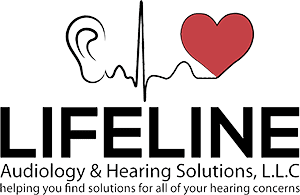Lifeline Audiology & Hearing Solutions
Hearing Aids
What Have You Been Missing?
Sign Up To Redeem Your
Hearing Aid Consultation
Sign up for this limited time offer of a consultation and screening with the team at Lifeline Audiology & Hearing Solutions.
Is It Time to Get Hearing Aids?
If you’re reading this, you may already suspect you might need hearing aids. If you answer yes to two or more of these questions, it’s time to schedule an appointment.
Do you & your significant other argue over what he/she told you?
Do others complain the TV is too loud?
Do you use the phrases, “excuse me”, “can you repeat that”, or “what did you say” several times a day?
Do you plan your nights out based on how loud it might be at your destination?
Do you avoid large family dinners because they're too noisy?
Brands We Carry
We have one to fit your lifestyle, your hearing loss and your budget.
Lyric Hearing Aids
We are proud to be one of the select offices in the United States to offer Lyric Hearing. Lyric was featured on Good Morning America as a new hearing technology that is not only tiny and invisible but also delivers exceptional sound quality without daily hassles.
Phonak Hearing Aids
Phonak has the right hearing aid for you – regardless of your type of hearing loss, your lifestyle, your personal preferences, your age or your budget. Phonak wireless accessories turn a myriad of communication challenges into easily accessible listening delight.
Oticon Hearing Aids
Our goal is to help people with hearing loss fulfill their potential while living the life they choose with the hearing they have. Oticon strives to be the leader in high-performance hearing solutions. Our goal is to provide you with the best hearing technology available
Widex Hearing Aids
Our uncompromising approach to innovation has led to such advances as the world’s first digital in-the-ear hearing aid, as well as our own revolutionary wireless technology
Starkey Hearing Aids
Helping millions of patients with never-before-seen hearing aid technologies. Starkey believes every person’s hearing loss is unique that’s why every solution they design is, too.
Signia Hearing Aids
Signia hearing aids deliver the sound that nature intended by combining uncompromised audibility with a natural sounding own voice hear everything in harmony.
Choosing Your Hearing Aid Provider
At Lifeline Audiology & Hearing Solutions, we go above and beyond the sale of a hearing aid. We will not only conduct your audiological examination, but we will program your hearing aids under the close watch of our professional audiologist. In addition, follow up appointments will make sure that your hearing aids are performing optimally. Just because your hearing aid has been programmed to the results of your audiogram does not necessarily mean it will perform its best in everyday real life situations.
Our audiologist will work with you,
Choosing Your Hearing Aid
The hearing aids we select for you are based on the results of the test, your budget, your lifestyle and a host of other factors. We promise to explain everything to you, without using a bunch of technical terms.
Professional Staff
For the best hearing healthcare, you should seek a professional, experienced and compassionate doctor of audiology.
Will Hearing Aids Improve My Hearing?
If you are hearing impaired, you will benefit from wearing hearing aids. However, the amount of benefit will depend on many factors.
- The length of time you waited before you did something about your problem.
- The hearing you have left (residual hearing).
- The degree to which your speech discrimination (word recognition ability) has been affected.
- Your overall health: diabetes, stroke, kidney disease.
- How well you adapt to change.
Your hearing loss didn’t happen overnight. Because hearing loss is generally a gradual change, you may not realize how severe your own hearing loss is and even be in denial of it. Change is difficult for anyone and much like if you got a new eyeglass prescription you would need some time to adapt, with hearing aids it’s no different. You must remain open-minded through the process and try to provide your audiologist with any positive or negative experiences you had with your hearing aids so that they can further fine tune the hearing aids to you on your follow up appointments. It may take some time to get the maximum benefit from your hearing aids.
Types of Hearing Aids
Invisible in Canal
Invisible-In-Canal (IIC) hearing instruments are
- 100% Invisible when worn
- Hear clearly in noise
- Sculpted for your ear canal
- Highest
definition sound quality - Designed for daily removal
Completely in Canal
Completely-in-the-canal (CIC) micro-technology allows this type of hearing aid to be worn deep inside the ear canal. CICs are so tiny, they are almost invisible when worn.
- Cosmetically desirable because these hearing aids are tiny in size
- Programmed to have automatic or
push button settings - Require good manual dexterity in order to place the hearing aid in the ears.
In the Canal
In-the-canal (ITC) hearing aids are smaller than the ITE style and are also custom made to fit the size and shape of your ear canal.
- Barely visible in the ear
- Easy to use with the telephone
- May not fit well in small ears
Behind the Ear
The behind-the-ear (BTE) style sits behind the ear, while the amplified sound passes down a tube to a customized earmold which fits in your ear.
- Typically offers more power than a custom-made hearing aid
- Robust for active wears
- Suitable for all degrees of hearing loss
- Large, easy-to-use hearing aids that are very reliable
Over the Ear
The Over-the-Ear hearing aid style that is very similar to the Behind-the-Ear style, but is much smaller and less noticeable. This style holds the electronics in a slim case that hooks over the top of the ear and hides behind the top of the ear, the same place where eyeglasses rest. A clear narrow tube follows the front of the ear and carries sound to the tiny
- Allows natural sounds to enter the ear canal
- Can be selected, programmed and fit in a single visit
- Very discreet and appealing to people with cosmetic concerns
- Does not require custom molding
Receiver in Canal
- Fits a large range of hearing loss
- Offers the greatest flexibility in programming
- Water resistant and very durable
Affordable Hearing Aids
Hearing Healthcare with Convenient Payment Plans
Care Credit Low Monthly Payment Plans
We offer CareCredit because we’re committed to your hearing health. CareCredit is a convenient, low minimum monthly payment program allowing you to purchase your affordable hearing aids today. With no up-front costs, no pre-payment penalties, and no annual fees, CareCredit lets you pay overtime and frees up cash and credit cards for the other things you need. It’s easy with immediate approval decisions.
Insurance
Certain insurance companies have a benefit towards the purchase of your hearing aid. Lifeline Audiology & Hearing Solutions will assist you in determining your benefit and in many cases directly bill your insurance for payment. Lifeline Audiology & Hearing Solutions participates with many providers who offer assistance toward payment of your hearing aids making them very affordable.
Solutions for Unique Problems
Rechargeable Hearing Aids
Rechargeable hearing aids are hearing aids that use a rechargeable battery instead of disposable batteries. Rechargeable hearing aids offer several advantages over disposable hearing aids, including:
- Convenience: Rechargeable hearing aids eliminate the need to carry around and change batteries.
- Cost: Rechargeable hearing aids can be less expensive to own over time, as you will not need to purchase disposable batteries.
- Environmental impact: Rechargeable hearing aids are better for the environment, as they do not produce waste from disposable batteries.
There are two main types of rechargeable hearing aids: lithium-ion and nickel-metal hydride. Lithium-ion batteries are more expensive than nickel-metal hydride batteries, but they have a longer lifespan. Nickel-metal hydride batteries are less expensive than lithium-ion batteries, but they have a shorter lifespan.
Accessories
Hearing aid accessories are devices that can be used to improve the performance of hearing aids or make them more comfortable to wear. Some common hearing aid accessories include:
- Batteries: Hearing aids require batteries, and there are a variety of different types of batteries available. It is important to choose the right type of battery for your hearing aids and to change them regularly.
- Cleaning tools: Hearing aids can become dirty and clogged with earwax, which can reduce their performance. It is important to clean your hearing aids regularly to keep them working properly.
- Cases: Hearing aids can be easily lost or damaged, so it is important to keep them in a case when you are not using them. There are a variety of different cases available, including hard cases, soft cases, and travel cases.
- Accessories for connecting to other devices: These accessories can allow you to stream audio from these devices directly to your hearing aids, which can improve your listening experience.
- Accessories for making hearing aids more comfortable: There are a number of accessories available that can be used to make hearing aids more comfortable to wear.
We’re happy to have a discussion with you about the different types of accessories that are available and which ones might be right for you.
Singled-Sided Hearing Loss
A BiCROS system consists of a microphone-equipped device that is fit to the poorer-hearing ear and a conventional hearing aid fit to the better-hearing ear that has some hearing loss.
CROS and BiCROS options
RIC
- Discreet design
- Industry’s first rechargeable CROS System
- Variety of color options available
- Easy to adjust
- Allows you to hear from both
BTE
- Discreet design
- Variety of color options available
- Easy to adjust
- Allows you to hear from both sides
Contact Us
We promise we don't send spam
Jacksonville
8553 Argyle Business Loop Ste D
Jacksonville, FL 32244
Fernandina Beach
Fernandina Beach, FL 32034
North Jacksonville
2255 Dunn Avenue., Ste 103
Jacksonville, FL 32218
Orange Park
Orange Park, FL 32073

